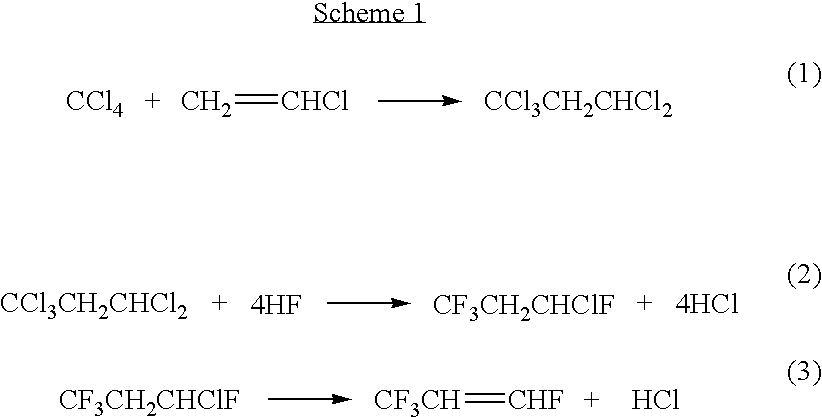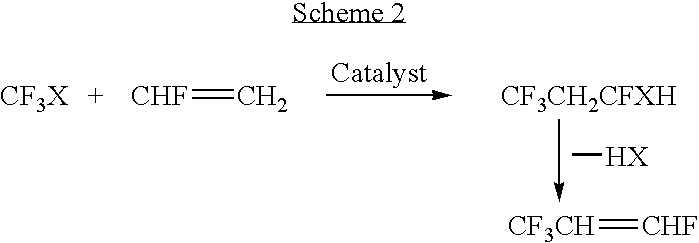Processes for synthesis of 1,3,3,3-tetrafluoropropene
a technology of tetrafluoropropene and process, which is applied in the field of synthesis of 1,3,3,3-tetrafluoropropene, can solve the problem of not disclosing a process specifically for the preparation of 1,3,3,3-tetrafluoropropen
- Summary
- Abstract
- Description
- Claims
- Application Information
AI Technical Summary
Benefits of technology
Problems solved by technology
Method used
Image
Examples
example 1
Synthesis of CF3CH═CFH via reaction of CF3I and CFH═CH2
[0034]In an autoclave, a mixture of FHC═CH2 (156 mmol) and trifluoromethyliodide, CF3I, (156 mmol) is heated at about 200° C. for 48 hours. The resultant reaction product comprised a mixture of compounds, including CF3CH2CFHI. The CF3CH2CFHI is separated from the mixture and purified by distillation to afford relatively pure CF3CH2CFHI. Crown ether (18-crown-6) (0.1 mmol) and CF3CH2CFHI (40 mmol) are added to 20 ml aq. solution of KOH (50 wt %) maintained at about 0° C. and heated to about 30-40° C. in an autoclav. The reactants in the autoclave was stirred for about 24 hours and gas chromatography of the volatile material indicates that the reaction product comprises about 75 mol % CF3CH═CFH; the ratio of trans isomer to cis isomer is about 9 to 1. NMR data: 19F (CDCl3) δ=−61.3 (3F, m) and −120.0 (1F, ddq, J=77, 15, and 9 Hz) ppm for trans; −58.4 (3, dd) and −110 (1F, ddq, J=78, 37 and 16 Hz) ppm for cis.
example 2
Synthesis of CF3CH═CFH via reaction of CF3Cl and CFH═CH2
[0035]In an autoclave, a mixture of FHC═CH2 (156 mmol) and trifluoromethylchloride, CF3Cl, (156 mmol) and catalyst Pd(Ph3)4 (0.1 mol %) is heated at about 200° C. for 48 hours. The resultant reaction product comprised a mixture of compounds, including CF3CH2CFHCl. The CF3CH2CFHCl is separated from the mixture and purified by distillation to afford relatively pure CF3CH2CFHCl. Crown ether (Aliquat® 336) (0.1 mmol) and CF3CH2CFHCl (40 mmol) are added to 20 ml aq. solution of KOH (50 wt %) maintained at about 50° C. in an autoclave / pressure bottle. The mixture in the autoclave / pressure bottle is stirred for about 24 hours and gas chromatography of the volatile material indicates that the reaction product comprises about mainly greater than about 65 mol % CF3CH═CFH.
example 3
Synthesis of CF3CH═CFH via reaction of CF3Br and CFH═CH2
[0036]In an autoclave, a mixture of FHC═CH2 (156 mmol) and trifluoromethylbromide, CF3Br, (156 mmol) and catalyst Pd(Ph3)4 (0.1 mol %) is heated at about 200° C. for 48 hours. The resultant reaction product comprised a mixture of compounds, including CF3CH2CFHBr. The CF3CH2CFHBr is separated from the mixture and purified by distillation to afford relatively pure CF3CH2CFHBr. Tetrabutylammonium bromide (0.1 mmol) and CF3CH2CFHBr (40 mmol) are added to 20 ml aq. solution of KOH (50 wt %) maintained at about 50° C. in an autoclave. The mixture in the autoclave is stirred for about 24 hours and gas chromatography of the volatile material indicates that the reaction product comprises about 75 mol % CF3CH═CFH.
PUM
| Property | Measurement | Unit |
|---|---|---|
| temperature | aaaaa | aaaaa |
| contact time | aaaaa | aaaaa |
| temperature | aaaaa | aaaaa |
Abstract
Description
Claims
Application Information
 Login to View More
Login to View More - R&D
- Intellectual Property
- Life Sciences
- Materials
- Tech Scout
- Unparalleled Data Quality
- Higher Quality Content
- 60% Fewer Hallucinations
Browse by: Latest US Patents, China's latest patents, Technical Efficacy Thesaurus, Application Domain, Technology Topic, Popular Technical Reports.
© 2025 PatSnap. All rights reserved.Legal|Privacy policy|Modern Slavery Act Transparency Statement|Sitemap|About US| Contact US: help@patsnap.com



